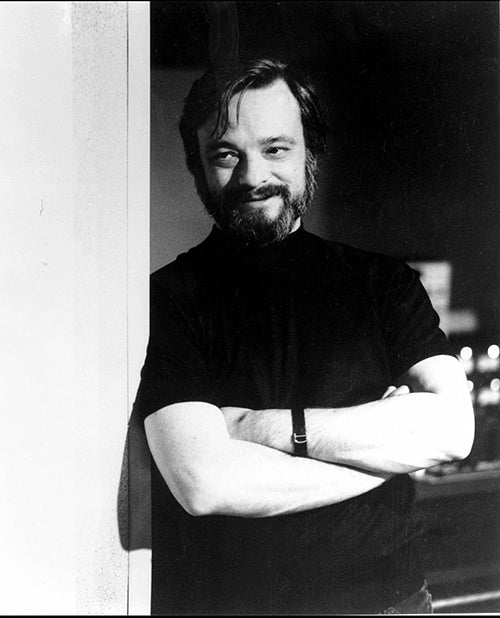Readers don’t necessarily rely on Copper for theatrical news, but there is a good reason why the recent passing of Stephen Sondheim (1930 – 2021) should matter to anyone interested in music: he is an integral part of American songwriting. Although Broadway cast albums rarely get the same treatment we audiophiles lavish on other recordings, Sondheim’s massive oeuvre is covered by hundreds of our favorite artists. You might think otherwise, but I guarantee everyone knows one Sondheim tune, “Send in the Clowns” from A Little Night Music (1973). It was brought to prominence by Bobby Short and then covered by Sarah Vaughn, Barbara Streisand, Frank Sinatra, Judy Collins, Shirley Bassey, Patti Labelle, Cher, Judi Dench, Peter Criss (KISS), and about 350 others. And if that isn’t mainstream enough, it was even performed by Dan Castellaneta as Krusty the Clown on The Simpsons.
As Sondheim reminds us in Six by Sondheim, a 2013 HBO documentary about six of his greatest songs, most popular music before rock and roll came from scripted live shows and Hollywood films. He is a product of both – stretching back to the original masters of song-crafting.
Let’s start in the murky past before the turn of the 20th century when downtown vaudeville and variety shows dominated theatre. As New York music publishing houses moved uptown from Union Square to Tin Pan Alley on 28th Street between Broadway and Sixth Avenue, entertainers followed. Set among the Garment District’s furrier houses displaying pelts, coats, and stoles, publishers employed musicians as “song pluggers,” selling sheet music by performing live for customers on rickety clangy upright pianos (the name Tin Pan Alley came from a newspaperman characterizing the sound of people in the building banging on pianos). Notable lyricists and composers came out of that tradition, including Cole Porter, Irving Berlin, George and Ira Gershwin, George M. Cohan, Oscar Hammerstein II, and many others who contributed to the development of theatre and movies as we know them.
To place Sondheim within this context, consider these three easy-to-remember eras of theatre while imagining black and white photo images of men, primarily, in shirt sleeves smoking cigarettes, banging on typewriter and piano keys, and scrambling to come up with the next big hit. Naturally, the timeframes are not intended to be exact, and the lists of performers and shows are not exhaustive.
1920 – 1940
This is the age of Richard Rodgers and Lorenz Hart, a prolific team until Hart’s death in 1943. Unless you’re a theatre enthusiast, their 1920s shows might not be familiar, but fans of crooners and jazz standards will undoubtedly recognize the songs from the 1930s:
“Isn’t it Romantic?” (1932)
“Blue Moon” (1934)
“My Funny Valentine” (1937)
“The Lady is a Tramp” (1937)
1940 – 1960
This era’s biggest hitmakers were Richard Rodgers (the same who collaborated with Lorenz Hart) and Oscar Hammerstein II, whose shows are recognizable to multiple generations.
Oklahoma! (1943)
South Pacific (1949)
The King and I (1951)
The Sound of Music (1959)
During the early 1940s, Sondheim became close friends with Oscar Hammerstein’s son, James. Due to his parents’ divorce and strained relationship with his mother, Sondheim spent so much time with the Hammersteins that they became his surrogate family. Oscar was also a teacher and musical mentor who essentially put 15-year-old Sondheim through Broadway boot camp in a single day as Hammerstein professionally critiqued “Stevie’s” high school play, By George! as “The worst thing I ever read.”
In the 1950s, classical composer Leonard Bernstein turned his attention to theatre and wrote the music for Peter Pan (1950) and Wonderful Town (1953). Bernstein’s most significant hit was a collaboration among bookwright Arthur Laurents, director Jerome Robbins, and a 25-year-old lyricist named Stephen Sondheim, on West Side Story (1957).
1960 – 2021
For the next 60 years, nearly every show on Broadway was a product of Andrew Lloyd Webber, Jerome Robbins, Harold (Hal) Prince (1928 – 2019), and Stephen Sondheim, or a collaboration of Prince and Sondheim on some of the pair’s most memorable shows:
Company (1970)
Follies (1971)
A Little Night Music (1973)
Pacific Overtures (1976)
Sweeney Todd (1979)
In 1981, Sondheim and Prince staged Merrily We Roll Along, an adaptation of George Kaufman and Moss Hart’s 1934 play, which was panned by the critics and closed after sixteen shows, ending Sondheim and Prince’s partnership. Nevertheless, the cast album and worldwide revivals have made it a staple of theatre majors and young performers to this day. It was a setback and disappointment for Sondheim, but future collaborator James Lapine convinced him to begin a new Off-Broadway project, Sunday in the Park with George, with Mandy Patinkin and Bernadette Peters. After rehearsals at the Laurie Beechman Theatre and a 25-show run at Playwrights Horizons on 42nd Street between Ninth and Tenth Avenues, Sunday moved to the Booth Theatre in 1984, where it ran for 604 performances. After Sunday in the Park with George, Sondheim would do just four more shows, but his legacy was cemented.
It’s rare for a living person to get a theatre named after them, but on March 22, 2010, Sondheim’s 80 birthday, Henry Miller’s Theatre on 43rd Street was renamed The Stephen Sondheim Theatre. At age 91 and after a year and a half of COVID lockdowns, Sondheim was back in his rightful place in early November of 2021, attended not one but two of his revivals: Assassins (1990), a story of America’s political complexities, and Company (1970), an account of marital complexities. He died shortly thereafter on November 26, 2021 at his home in Connecticut.
 Stephen Sondheim Theatre, New York. Courtesy of Wikimedia Commons/ajay_suresh.
Stephen Sondheim Theatre, New York. Courtesy of Wikimedia Commons/ajay_suresh.
Naturally, there were numerous tributes, and kind words followed, but Stephen Sondheim’s send-off was different. He seemed to belong more to the fans, actors, writers, and musicians, and less to the industry. Online theatre forums overflowed with messages of heartfelt adoration and grief. Theatre lovers jammed into Greenwich Village piano bars to sing the standards long into the night. Others sang along at home with worn out show albums, while cast members from current Broadway shows gathered in Times Square to sing “Sunday” from Sunday in the Park with George.
Sondheim wrote with honesty, passion, and love, and that’s what connected with people. He did not strive for happy fluff but rather challenged us with the human condition with all its joy, sadness, and disappointment. As a life-long admirer of his own teachers and mentors, Sondheim also taught his students how to sing, write, communicate, hear, and see. Some successful artists can be selfish about sharing their craft, but Sondheim loved to nurture new talent such as future Broadway stars Jonathan Larson (1960 – 1996), the co-creator of Rent (1996), Lin-Manuel Miranda, and even Richard Rodgers’ grandson, Adam Guettel, a composer and lyricist.
He also taught by example: that not every play should or can be a hit; muses cannot replace hard work; money doesn’t mean success and vice versa; and some works take years to mature and be rediscovered with fresh eyes and ears. When Arthur Laurents, bookwright of West Side Story, was ready to revive and revise the show in 2009, he and Sondheim worked with Lin-Manuel Miranda to culturally update the staging. In a fitting homage to the play, more Spanish-speaking and Spanish-singing actors were cast in the roles. Sondheim also worked with Steven Spielberg and Tony Kushner on the latest, more diverse, film version of West Side Story, which premiered at Lincoln Center on November 29, 2021. Thirty percent of the new dialogue is in Spanish.
After influencing three generations, it remains to be seen who the next legend to continue the tradition of Hammerstein, Bernstein, Sondheim, and all the others who fill our lives with music, drama, and song will be. At 41 years of age, Miranda is certainly a contender, but the possibility of the next great collaboration exists whenever young people get together and say, “Hey, let’s put on a show!” Or, maybe there’s a future Sondheim in some young kid who’s unearthed their grandparents’ cast albums and finds themselves riding the subway humming,
“…Walking off my tired feet.
Pounding Forty-Second Street
To be in a show.
Oh…
Broadway Baby,
Learning how to sing and dance,
Waiting for that one big chance
To be in a show.
I’m a Broadway Baby,
Slaving at the five-and-ten,
Dreaming of the great day when
I’ll be in a show.
“Broadway Baby”
Follies (1971)
Header image: Stephen Sondheim in 1976.



